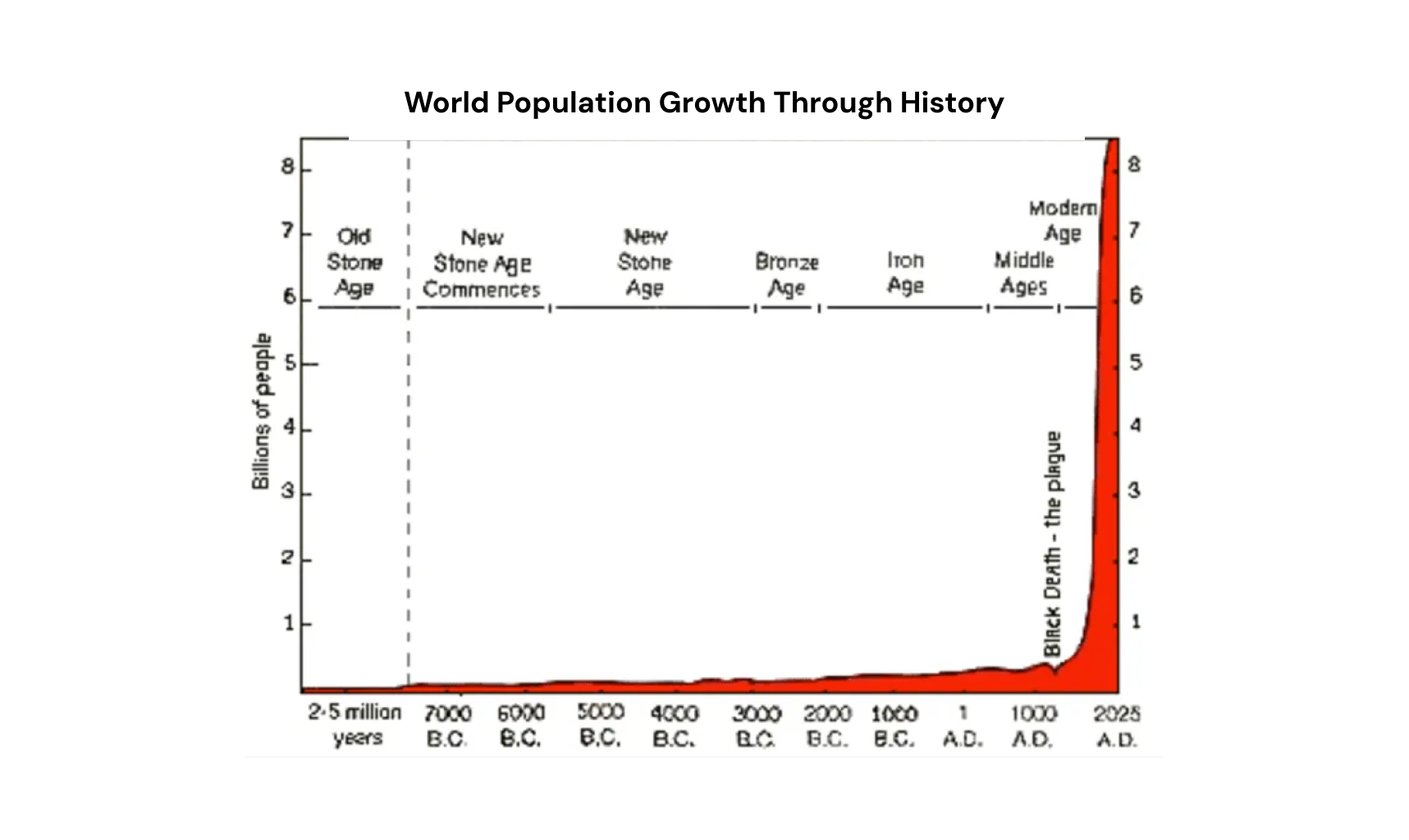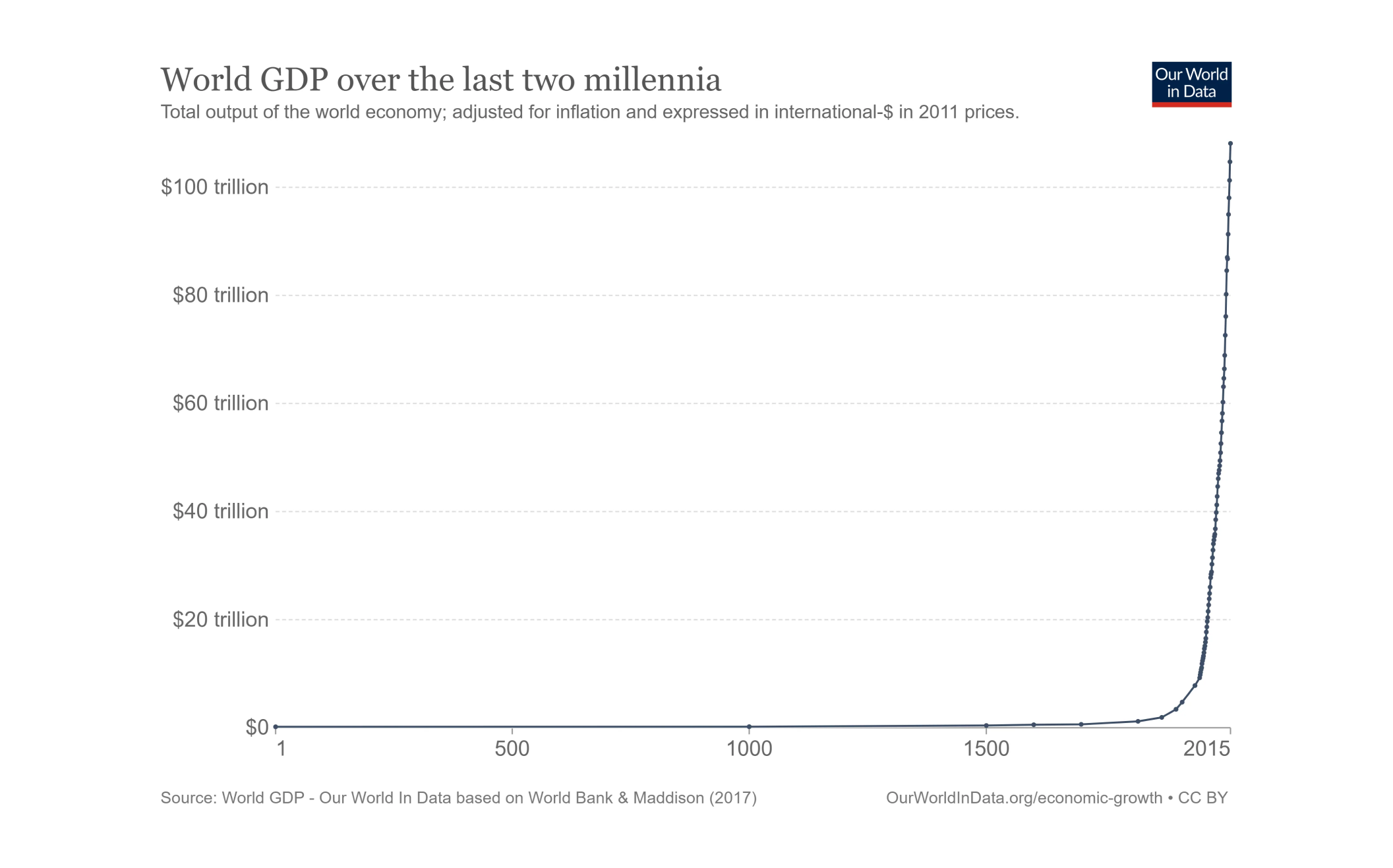In Part VII, we looked at the near-term future of the energy industry through a practical lens, building on everything we've explored so far.
Now, we'll zoom out to consider the long-term trajectory of human civilization and how energy fundamentally shapes it.
In Part I, we established the close link between energy, economic growth, and technological progress.
Here, we'll take this idea to its logical conclusion, exploring the full implications of this connection for the future of human development.
This final section goes beyond energy alone, offering a broader view of how civilization's growth might unfold, and where it could ultimately lead us.
Growth
Humanity is growing quickly.
Modern societies have come to view growth as a basic fact of existence.
Our financial systems, governments, and markets are all designed around the expectation of continuous growth.
For example, banks depend on growth to ensure loans can be repaid with interest, investors rely on growth for returns, and governments shape their monetary policies around expected GDP growth of 2-3% per year.
However, growth is not guaranteed.
When we look at history, we see that growth has been rare and episodic. It is more the exception than the norm.

population growth after the industrial revolution[1]
For most of human history, population and economic growth were stagnant, with only two major periods of sustained expansion.
By the end of the Paleolithic Period the world’s human population is estimated to have been between five and six million.
Following the Neolithic or agricultural revolution, the population made its first major leap, reaching over the short span of 8,000 years around 150 million by the year 1000 BCE.
For the next two and a half thousand years there was relatively little change. World population had reached about 500 million by the middle of the 17th century.
During this time any tendency for population to grow was punished by the checks of starvation and pestilence.
Only with the Industrial Revolution of the 18th century did population growth break out again from its Malthusian fetters.
- Brittanica
[2]
As we saw in Part II, growth during these periods resulted from breakthroughs in our ability to harness energy, which allowed humanity to escape the limits imposed by famine and disease.
These periods of growth not only saw population explosions but also economic expansion, where more energy was used to improve human well-being.

economic growth after the industrial revolution[3]

growth in energy consumption during the industrial revolution[4]
This raises an important question: Should society be built around growth, given its rarity in human history?
Some argue that depending on continuous growth is inherently unsustainable.
They suggest that we should shift our focus toward stability, and move away from relying on growth as the primary driver of progress.
It's true that uncontrolled growth can lead to problems like resource depletion and inequality, but growth has also been the primary driver of prosperity throughout our history.
When we look to the past, we see that much of the abundance we enjoy today can be attributed to the short-lived periods of growth that have gotten us here.
In addition, growth is about much more than increasing wealth.
It’s fundamentally about creating more value with less.
In a world where energy is the foundation of all change, economic growth is about capturing more energy and using it to improve human life.
There are only two ways for humanity to keep growing:
- Capture more energy
- Create more value with less energy
Technology describes anything that lets us capture more energy or create more value with less energy.
What we call technology today is really just new technology.
But all human creations built to use more energy or do more with less energy are technologies.
In order to keep growing, we have to keep creating better technology that can capture more energy and create more value with less energy.
We've seen that humanity has a clear path to abundant energy.
This starts with capturing more of the 173,000 TW of solar energy available to us through rapidly improving photovoltaic technology and solar deployments.
To go beyond this, we'll need to harness nuclear power, initially from breeder reactors, which we've seen can last >20,000 years.
This should buy us time to develop D-T fusion, and eventually D-D fusion that can supply us with abundant energy for >1 billion years.
However, the path to abundant energy is not without challenges.
Expanding solar and nuclear energy at scale will require vast resources.
Mining for critical materials and managing nuclear waste could become limiting factors as we progress toward energy abundance.
Aside: The Kardashev scale
We have shown that the growth of humanity directly depends on our capture and use of energy.
The Kardashev Scale provides a way to measure the level of advancement of a civilization based on how much energy it can harness.

- Type I civilizations capture all the energy available on their home planet. As humanity increases its use of solar and nuclear energy, we gradually progress toward this milestone.
- Type II civilizations capture the energy of an entire star, using technologies like Dyson spheres.
- Type III civilizations control the energy of an entire galaxy
- Type IV civilizations harness the energy of multiple galaxies.
At first glance, the Kardashev scale might seem farfetched - especially after Type I, which itself is still far beyond our current capabilities.
However, the purpose of the Kardashev scale is not in offering a near-term roadmap for our progress.
Instead, it helps us think about the long-term potential of humanity's technological and energy advancements.
By explicitly framing civilization's progress in terms of energy, the Kardashev scale pushes us to think about what humanity may eventually achieve as we push the boundaries of growth and energy use.
Our growth is constrained by the rate at which we can create and use technology.
Creating and using technology requires us to:
- understand our environment
- exploit this understanding to create new tools and use them to accomplish specific goals
Intelligence is what enables us to understand our environment and use this understanding to accomplish goals.
We can define intelligence as the ability to accurately model reality.
The rate at which we create and use technology is constrained by the total amount of intelligence available to us.
In the past, intelligence has exclusively come from humans.
The collective intelligence of humanity is limited by the number of humans alive and the quality of our education systems.
Unfortunately, human population can't grow indefinitely, and good education systems are even harder to scale.
So human intelligence has always been unscalable, and has remained a primary constraint on our economic growth.
With digital intelligence, we can now scale our ability to understand and manipulate the world, no longer limited by the constraints of human cognition or the slow pace of education.
This has the potential to unbind growth, as our capacity to create and use technology expands far beyond what human intelligence alone could achieve.
If we can continue to innovate in both energy and intelligence, we may approach an era where growth is no longer a rare event, but a continuous process driving humanity toward unprecedented levels of abundance.
Abundance
The good future of AI is one of immense prosperity, where there's an age of abundance, no shortage of goods and services [...], and everyone will be able to have anything they want. I think that future is 80% likely.
- Elon Musk
[5]
As we've seen, growth has historically been rare, but when it occurs, it drives immense prosperity and progress.
If current trends in digital intelligence continue, the future could bring a new kind of growth: one that is abundant and unbounded.
In an abundant future, the economic constraints that exist in modern civilization could disappear, allowing the focus of human life to shift from production to experience, exploration, and creation.
Aside: Is the abundant future likely?
It's important to note that this section is not a prediction of what will happen, but rather an exploration of what could happen if we are able to overcome a few challenges.
There are two major obstacles in front of us before we can reach this abundant future:
- Capabilities - Digital intelligence may never become advanced enough to fully automate economic value creation.
- Alignment - Even if AI becomes highly capable, controlling it to align with human values may prove difficult.
While a full discussion of these challenges is beyond the scope of this deep dive, current trends suggest we may overcome both.
Even Elon Musk, who has been vocal about the danger of AI for the past decade, recently said at the All-In Summit that he now sees an "80% chance" of an abundant AI future, with a "20% risk of annihalation."
This shift highlights that an abundant future isn't just possible, but likely - though significant risks remain.
For a deeper understanding of the constraints driving AI progress, check out my deep dive on deep learning
Historically, humans have been the primary source of intelligence, required to allocate energy and create value in society - including meeting our basic survival needs.
This has kept us bound to nature, always expending effort to ensure our survival.
Now, with the rise of digital intelligence, we're approaching a world where machines could automate economic value creation.
If AI systems are able to manage energy production, generate energy surpluses, and use these surpluses to run the systems of society without human intervention, humans could be freed from all labor for the first time in history.
In such a world, growth would no longer just mean more wealth or productivity, but also more time for humans to focus on creative, intellectual, or exploratory pursuits.
Digital intelligence might optimize existing systems while humans turn their attention to the frontiers of knowledge and innovation.
Alternatively, digital intelligence may completely surpass human intelligence. In this case, we may no longer need to participate in economic production at all.
As digital intelligence takes over economic production, the question arises: what will humanity do next?
Freed from the need for labor, humans will be forced to seek meaning in other places.
Aside: The universal game
"The most likely issue is how we find meaning in a world where AI can do everything we can do, but better."
- Elon Musk
[5]
In a world where digital intelligence manages our systems and energy needs, humans could be freed from labor - but what will we do with our time?
After our basic needs are met, humans turn to our deepest nature for fulfillment: play — the drive to expand through exploration, understanding, and creation.
This idea makes more sense when we look at some of the most insightful bodies of wisdom on human experience.
For example, South Asian philosophy speaks of lila, or "play," as the ultimate joy.
Mihaly Csikszentmihalyi's research on Flow shows that humans achieve peak well-being when challenged and expanding.
Neuroscience reveals that the dopaminergic play system is central to our most fulfilling experiences.
The universe is the ultimate game for humanity.
What we can do in the universe is explicitly defined by the changes we are allowed to cause based on the energy we have access to.
The universe sets the constraints, and energy gives us the power to shape our surroundings.
As we capture more energy, we gain more freedom in the game of life, unlocking our potential for creativity and expression.
As the universe trends toward entropy and disorder, life creates pockets of order and structure through it's use of energy.
In a future of abundance, energy becomes more than just a resource for growth; it becomes the key to unlocking humanity’s creative potential.
As we capture and control more energy, we don't just fuel progress; we shape the universe around us, turning our local expanse of space into a canvas for the expression of life.
